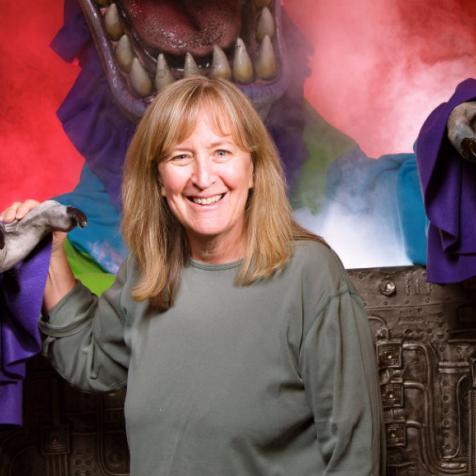
Company Details
Location
Greeley, Colorado
Founded
1978
Ownership Type
Private
Employees
11
Products
Halloween masks and animatronics
Greeley, Colorado
Founded: 1978
Privately owned
Employees: 11
The macabre creations from Ed and Marsha Edmunds have revolutionized the haunted house industry.
Ed Edmunds famously traded his motorcycle for a barrel of latex and started making Halloween masks in 1978.
He made a name for himself making some of the wickedest masks on the market, everything from decaying zombies to psychedelic demons. But then a flood of cheap masks started flooding in from China, and Ed knew it was time for a change.
In 1994, Distortions shocked the haunted house industry with an animatronic electric chair, complete with a thrashing inmate on the hot seat. "It was not pneumatic," recalls Ed. "It was just a motor, a furnace motor. It just shook the heck out of him."
The company had already gotten into large props for haunted houses and other dark attractions, but this was something entirely different. "Nobody had seen anything like it," says Ed. "It truly changed haunted houses. They could spend money and make money. The industry shifted and it became big business."
They sold 200 electric chairs in one year and have done several different variations over the years, including a pneumatic version, one that invites haunted house visitors to take a seat, and even a kiddie-sized one. "For us, the electric chair is like Rick Baker and gorillas," says Ed.

Distortions' animatronics got increasingly complex and creative. The Edmunds started selling huge inflatable haunted houses shaped like dragons and castles about a decade ago. Then the company filled a wide-open market niche with Frightronics, a new line of value-priced animatronic characters launched circa 2006. "We were able to make them so they'd wholesale for $200 to $250," says Ed. "That's unheard of."
Another relatively new line, Shocktronics, plays on people's familiarity with animatronics in haunted houses and replaces the robot with a live actor who jumps out and scares the bejeezus out of haunted house customers. "This wouldn't have worked before the electric chair," says Ed. "It only works because people are so used to animatronics."
A reality show on the Travel Channel from 2011 to 2013, Making Monsters, raised their national profile, leading Distortions to come full circle and again start selling to consumers as well as haunted houses.
New this year is The Monster of the Month, a subscription of creepy masks and props for diehard fans. For about $30 a month, the delivery "could be anything," warns Ed. "We're going to mix it up a lot. It could be a mask, a beast's arm, or anything else."

Halloween animatronics are still Distortions' bread and butter, and it remains a seasonal business -- but not as much so as you might expect. "We're busy all year," says Ed. "When you get to September and October, people are getting a little panicked. It's more chaos."
Distortions is growing, "particularly in the last couple of years," says Marsha. "We've been doing a lot more custom work. There's a big increase in customers."
With the boom times, the company is looking for more local manufacturing partners. "95 to 98 percent of it is all done here," says Ed. "There's a few things we have to partner with other people, like when we do the giant inflatables. The Beast is 150 feet long and you walk through his mouth."
Distortions works with a styrofoam shop in Nebraska to make oversized skeletons and the like, but they'd like to find Colorado companies to work with, particularly Colorado-based Fiberglas shops. Most large-scale Fiberglas whops are in California, and it's tough to ship, says Marsha. "We end up doing big, stupid plaster molds."
"Over the years, we've done a lot of everything ourselves," says Marsha. "But since the really early years, we bring people in -- freelancers, sculptors, artists. The main crew here has been with us for 15 to 20 years." That's critical, she notes. "So much of it is learned on the job."
The skill set encompasses pneumatics, mechanics, electronics, sculpture, and painting. "It's art on a massive scale," she adds.
"With lots of physical labor," interjects Ed, finishing his wife's sentence.

Challenges: Durable products. Planned obsolescence is not part of the Distortions business model. "Unfortunately, [the animatronics] last forever," says Marsha. "There was a guy who had his haunted house burn down and the only thing left was the electric chair."
But it's not ultimately a bad thing, adds Ed. "I would rather do that [make quality products] than have people spend a lot of money and have it break."
Opportunities: There are about 2,500 haunted houses in the U.S., generating roughly $300 million annually, according to the Haunted Attraction Association. "I think it's still growing," says Marsha. "Home haunters are booming -- people opening up haunts in their home or garage." Some clients even spend tens of thousands of dollars on custom animatronic flying saucers, jack-in-the-boxes, and gargoyles for lavish Halloween parties, say Ed.
International sales are up for Distortions, Ed adds, and corn mazes are a growing domestic market. "We've had farmers come up to us at the trade show and shake our hand and say, 'You saved the family farm,’" says Ed. Many maze operators make as much off their Halloween attractions as they bring in from agriculture, with much higher margins, he adds -- 1 percent vs. "pure profit."
Needs: A break. "Our life is hard," laments Ed. "I don't know how long it's been where we're working seven days a week and flying all over tarnation. A lot of people glamorize what we do, but at the end of the day, you're signing up for punishment if you get into the entertainment business, and we're no different.

